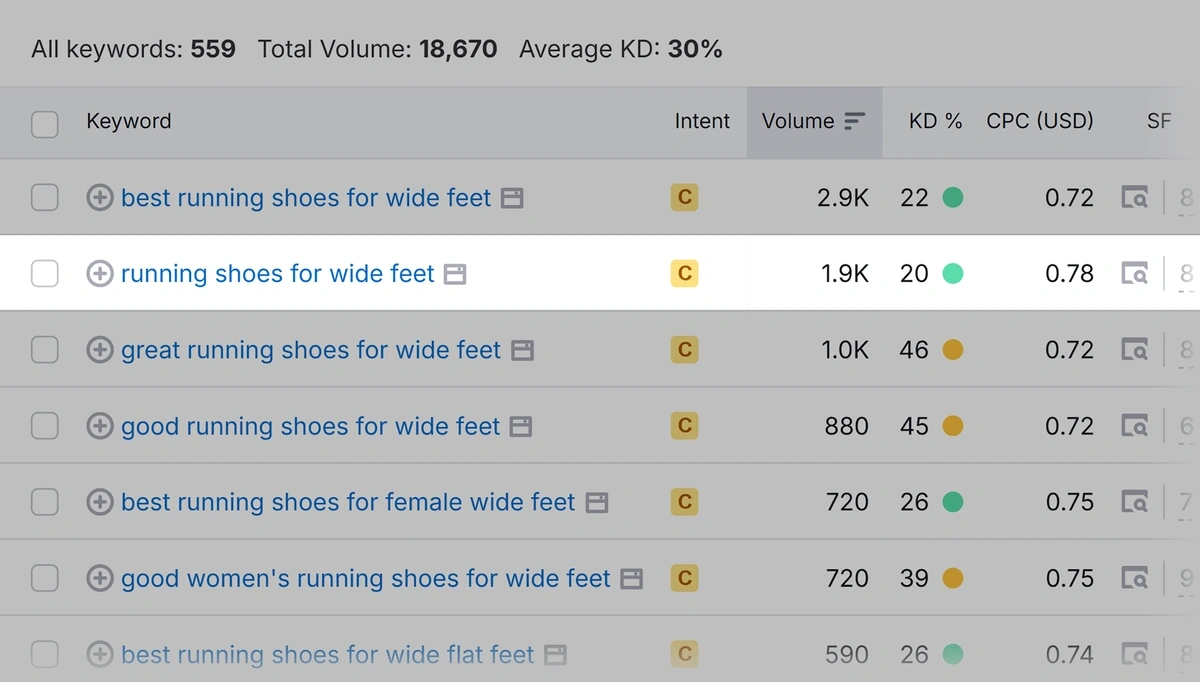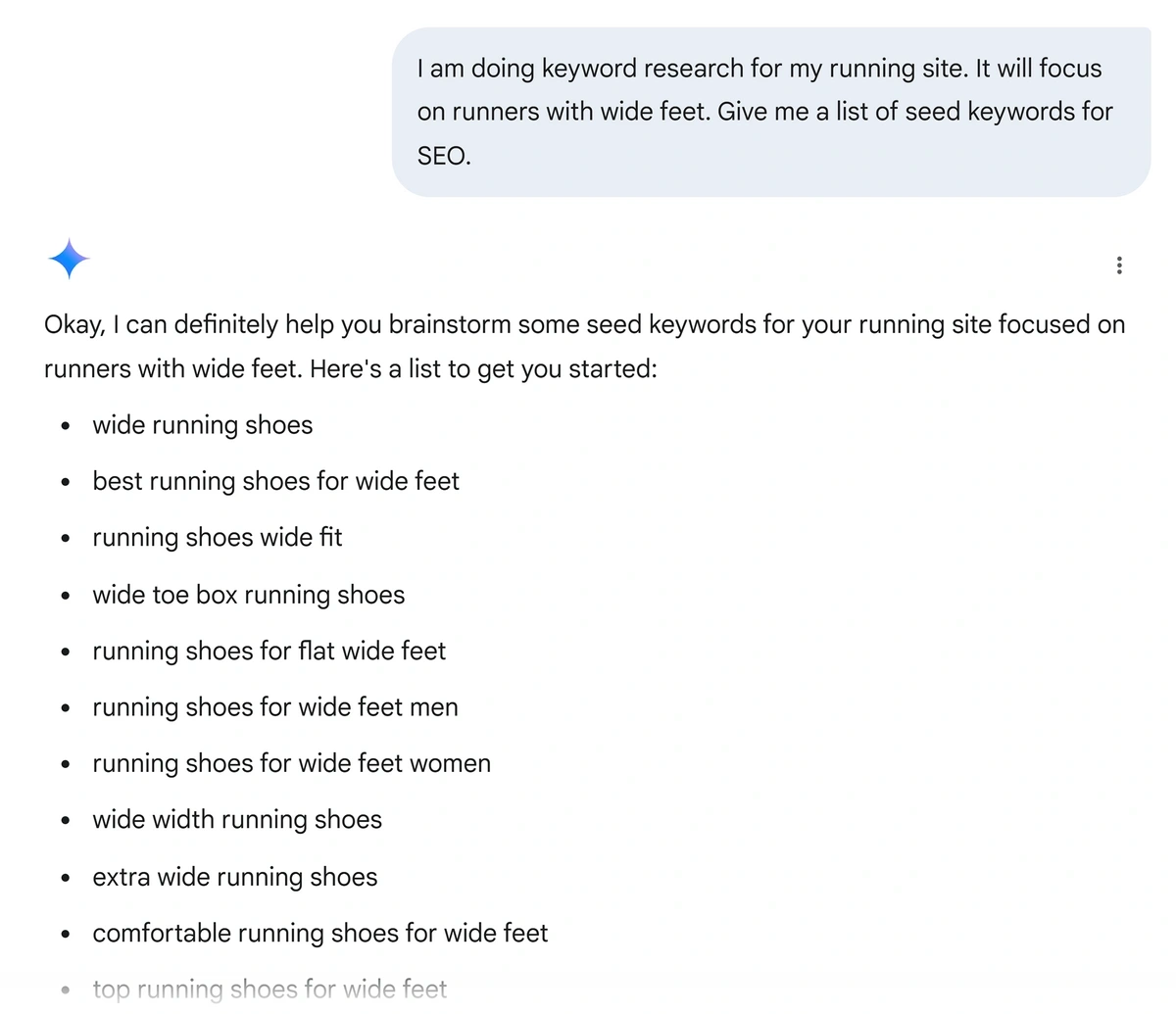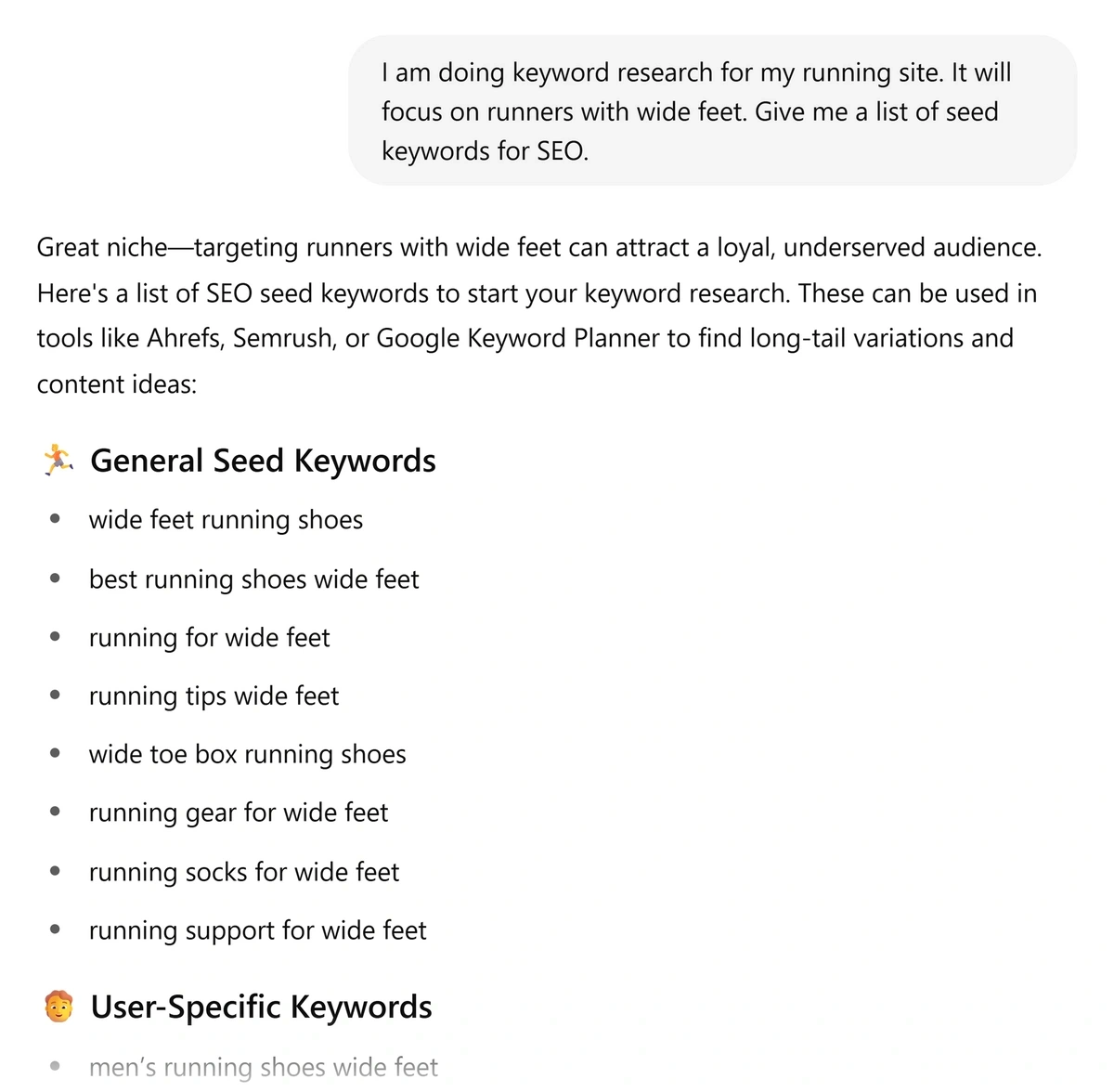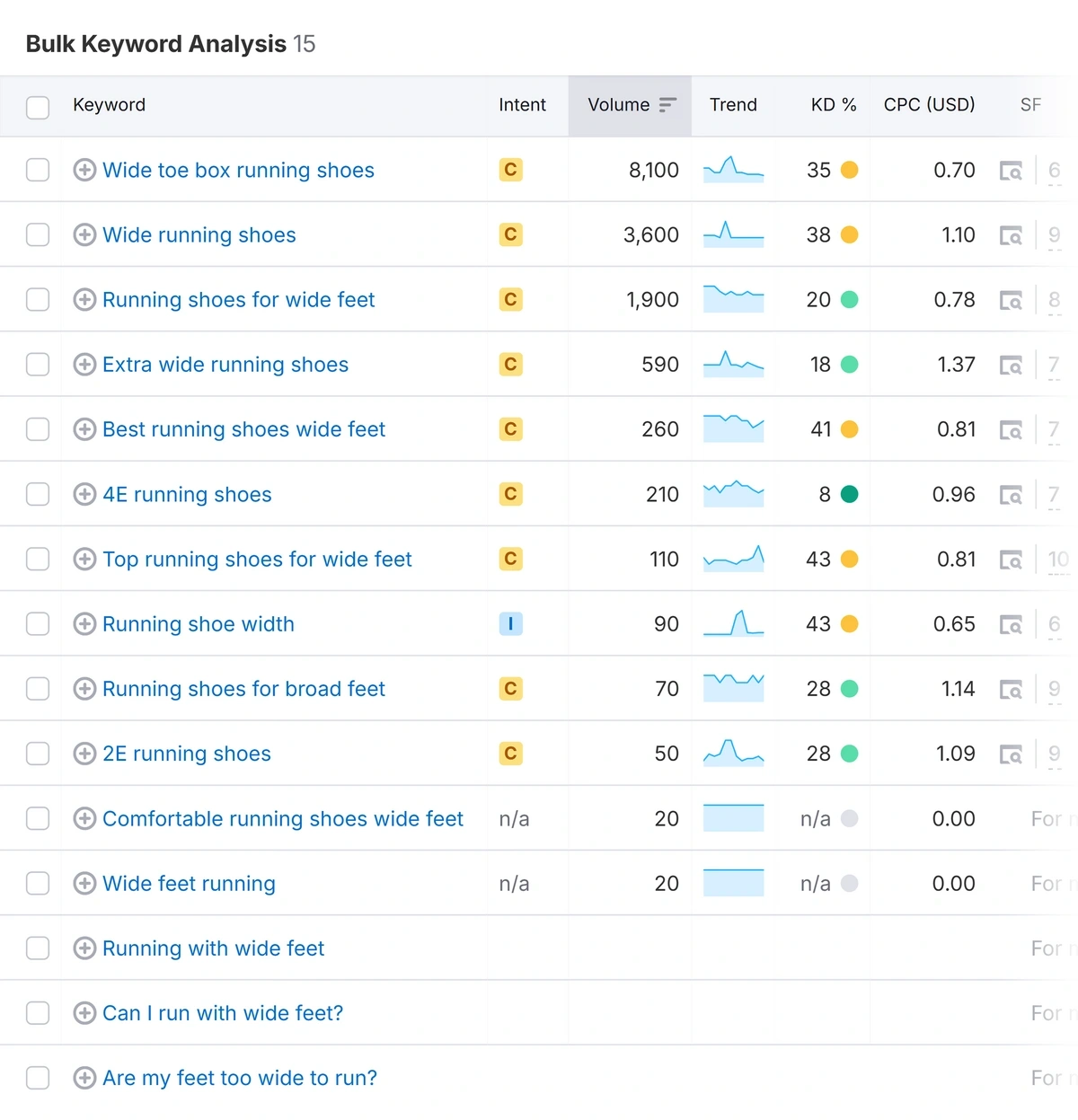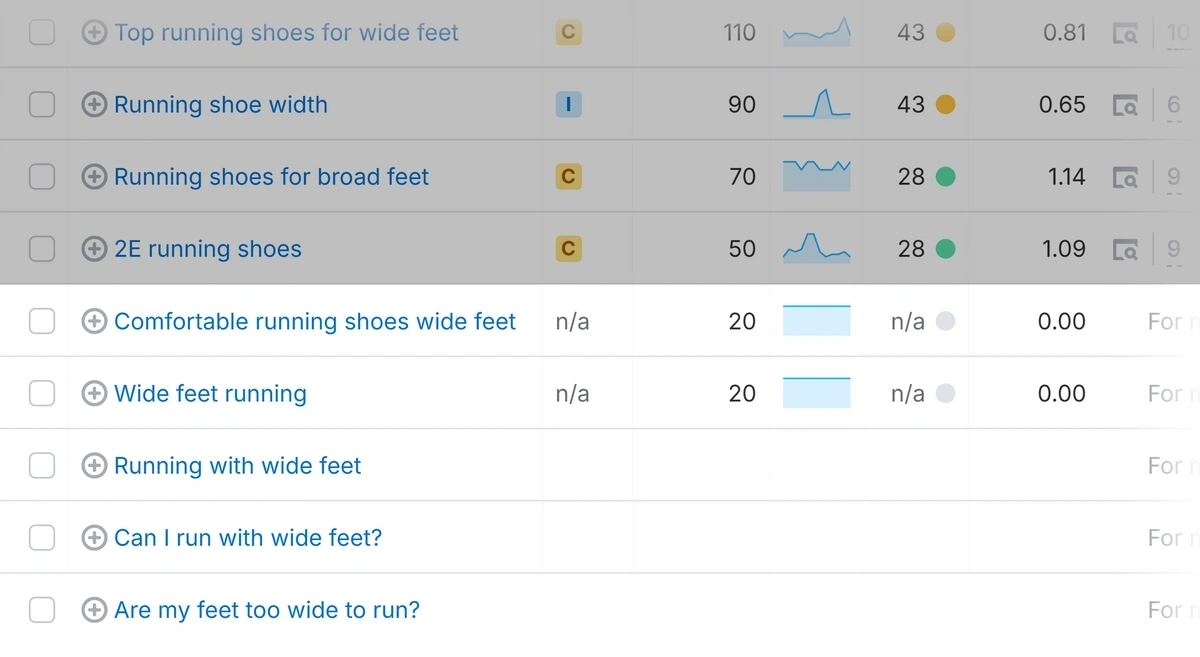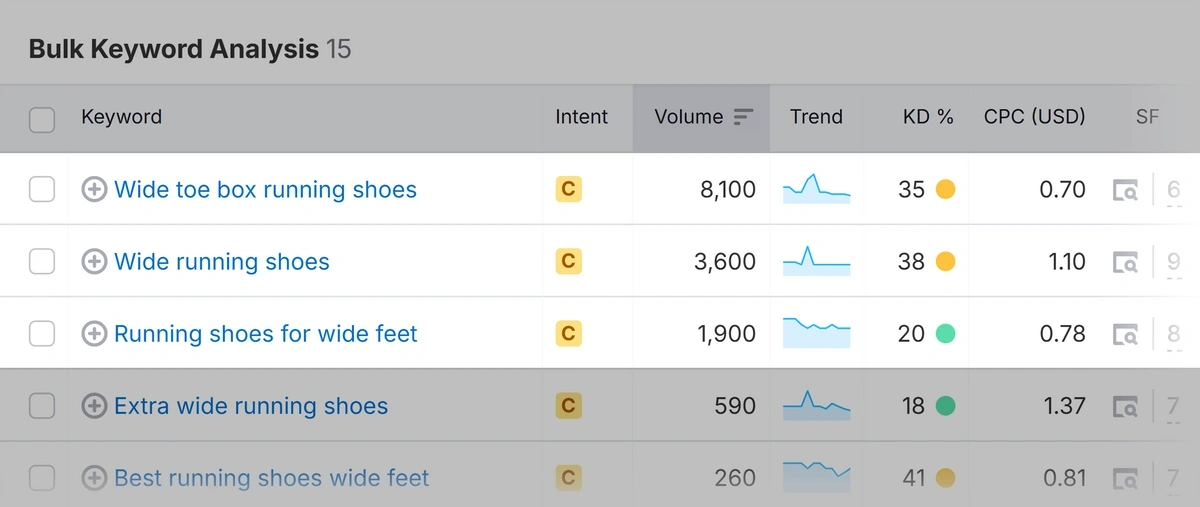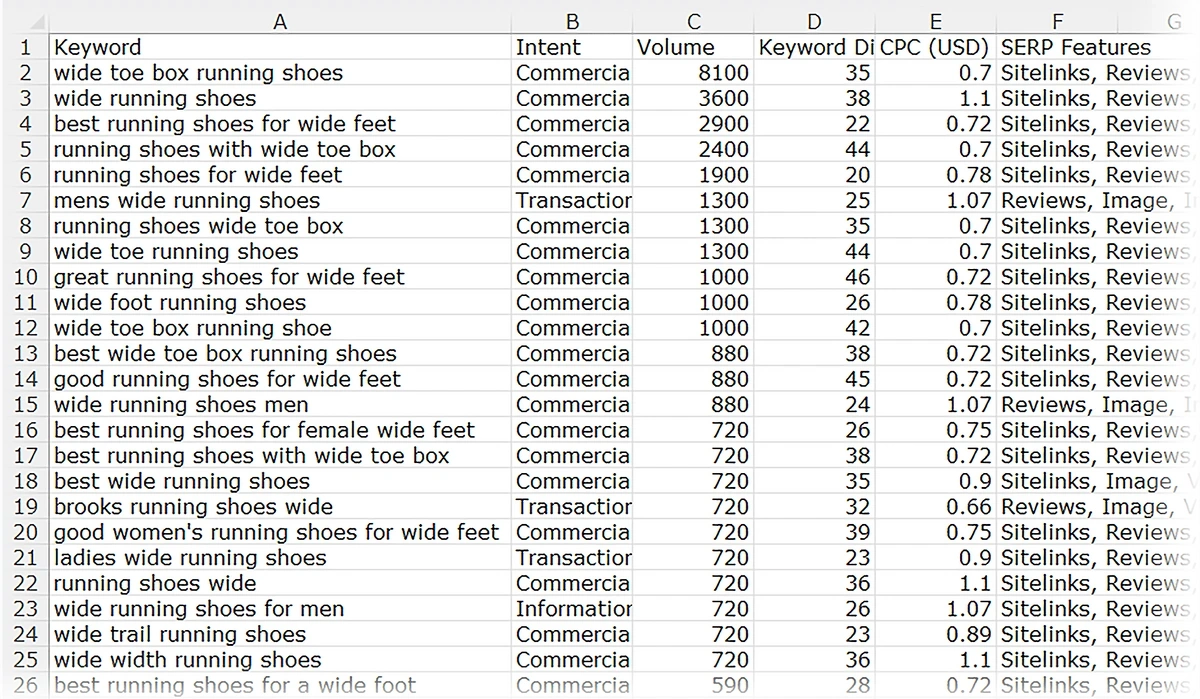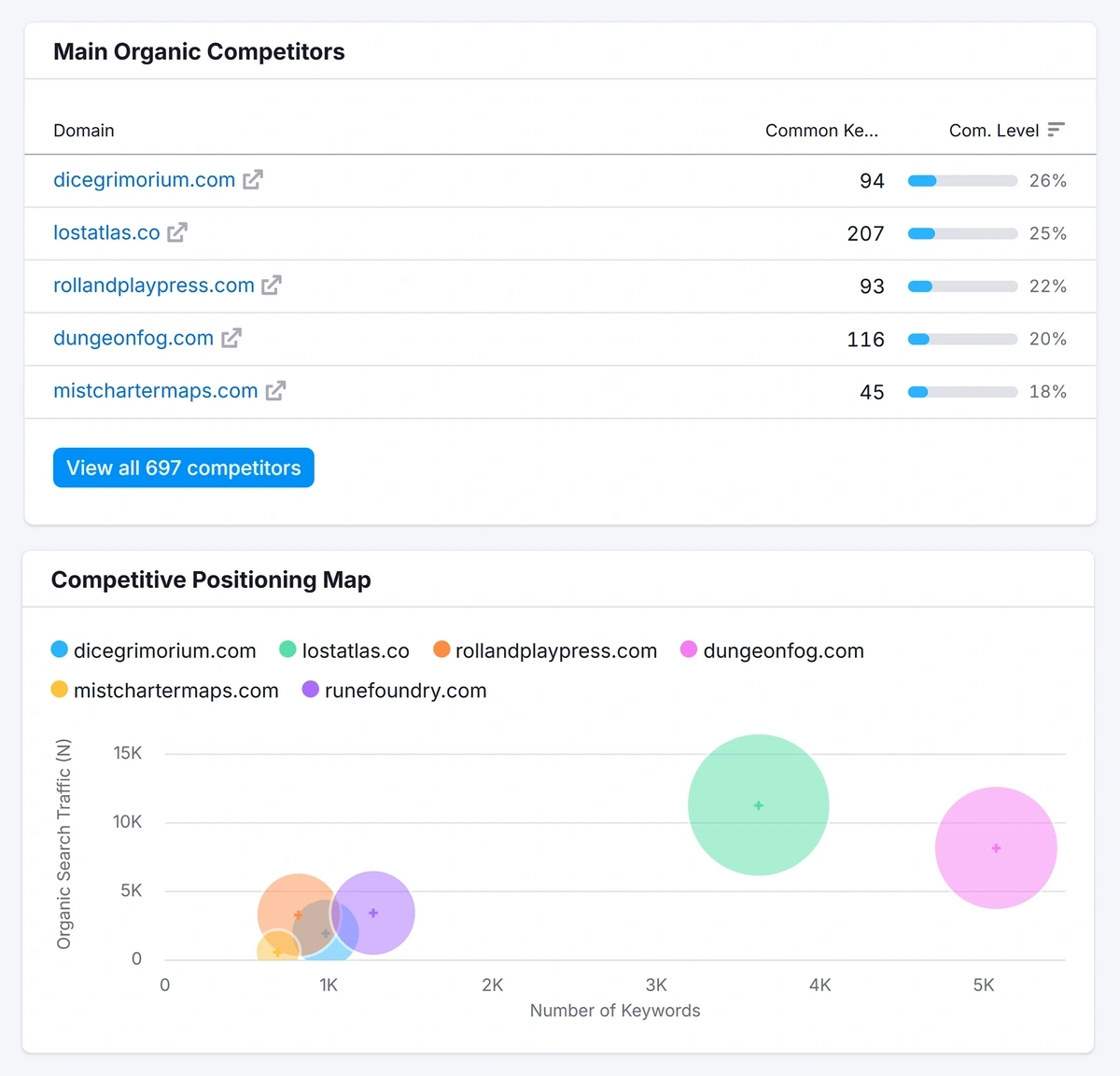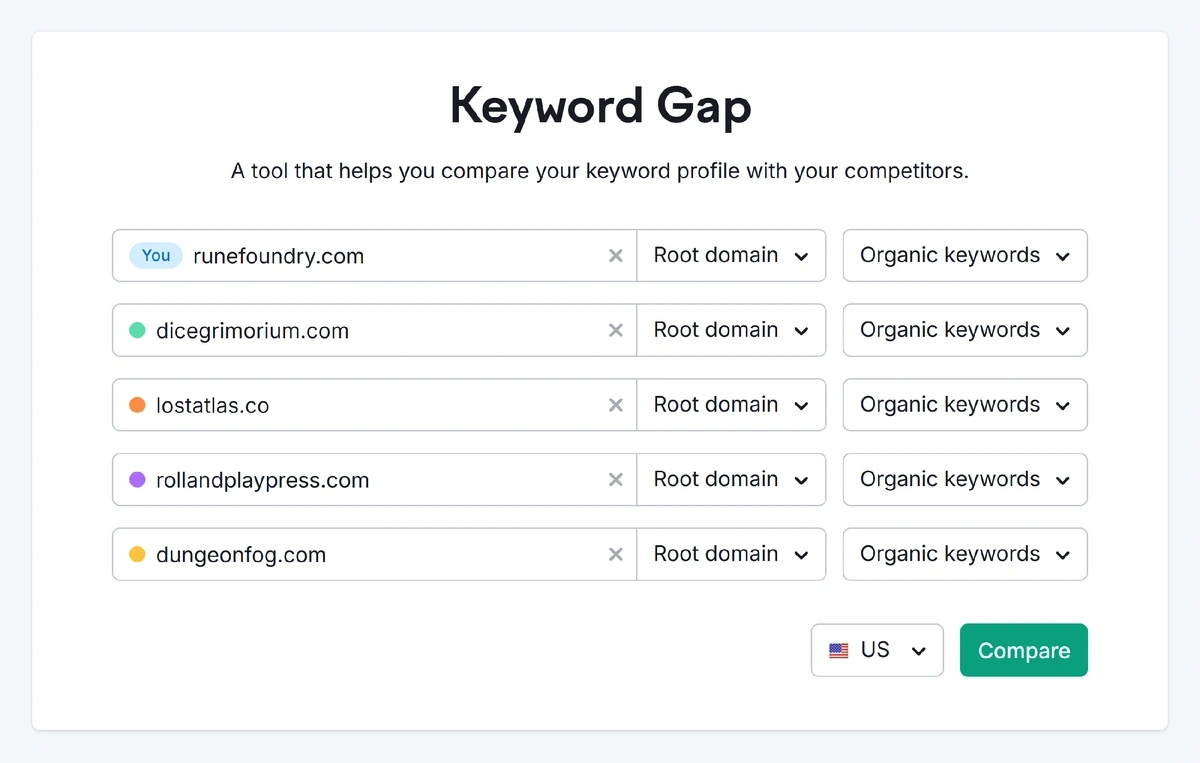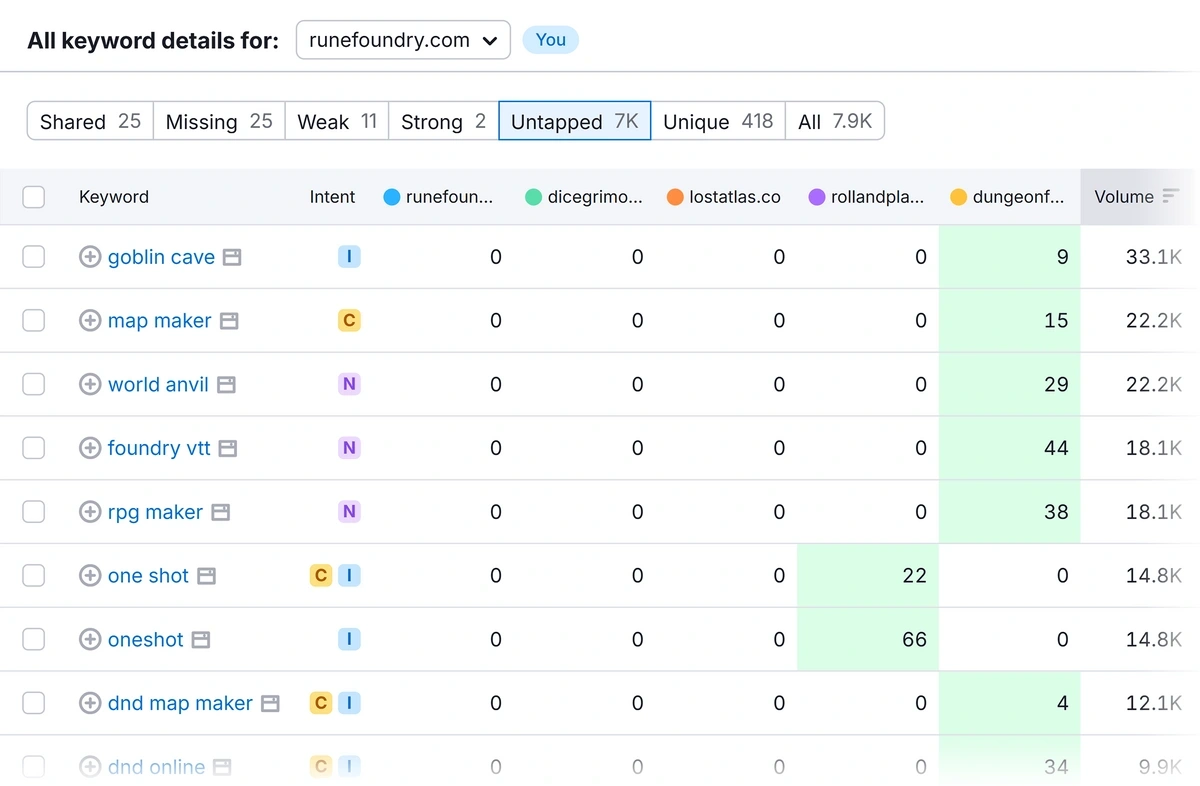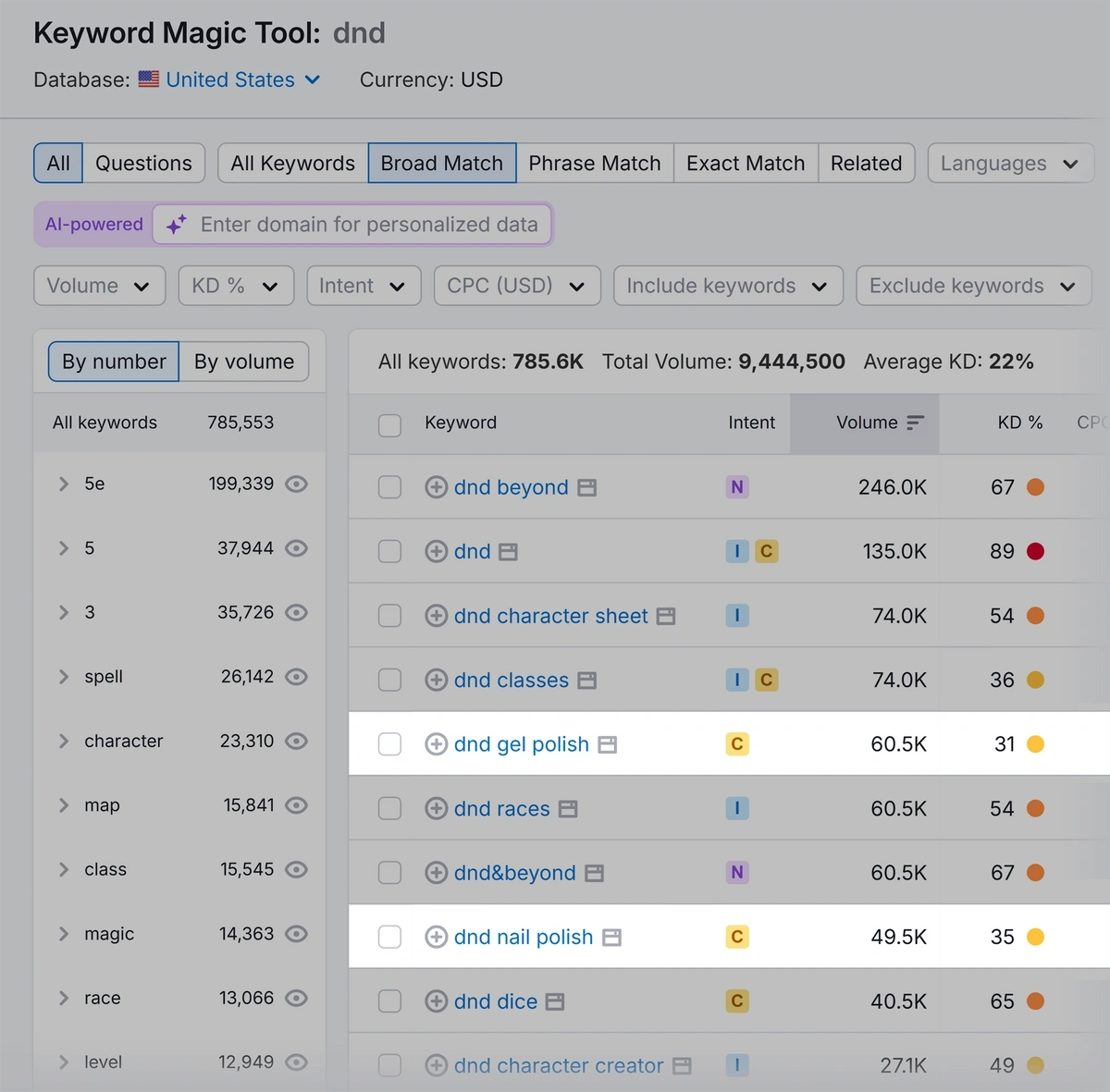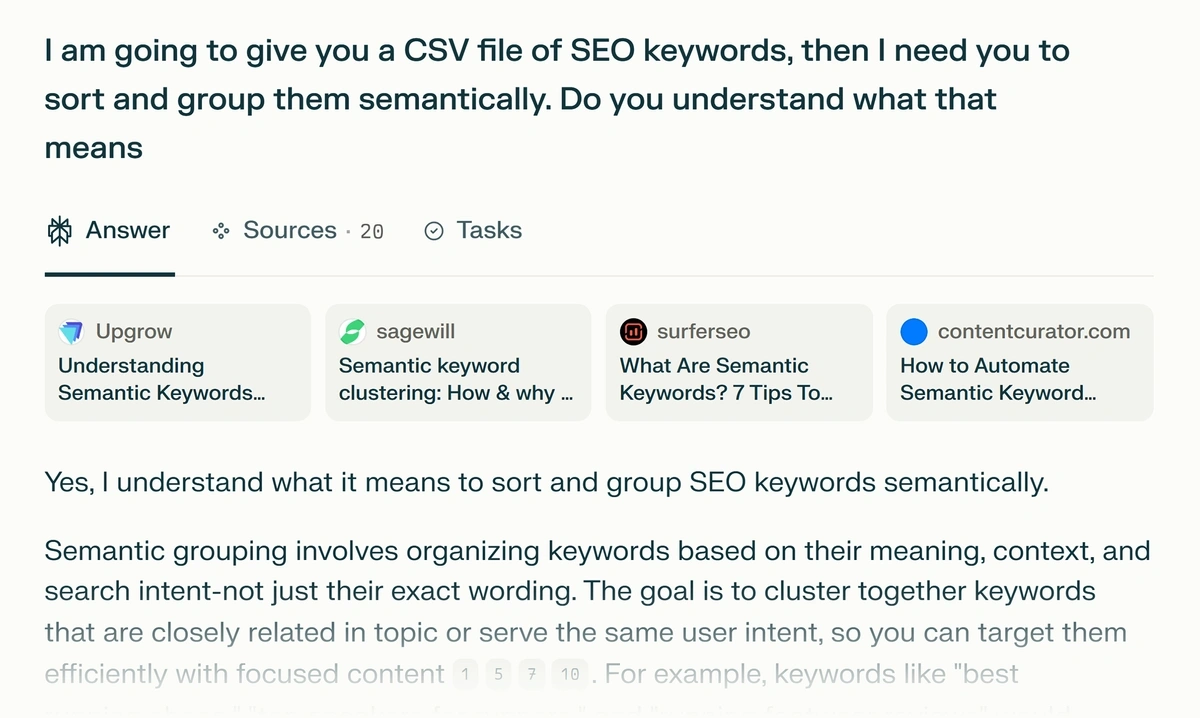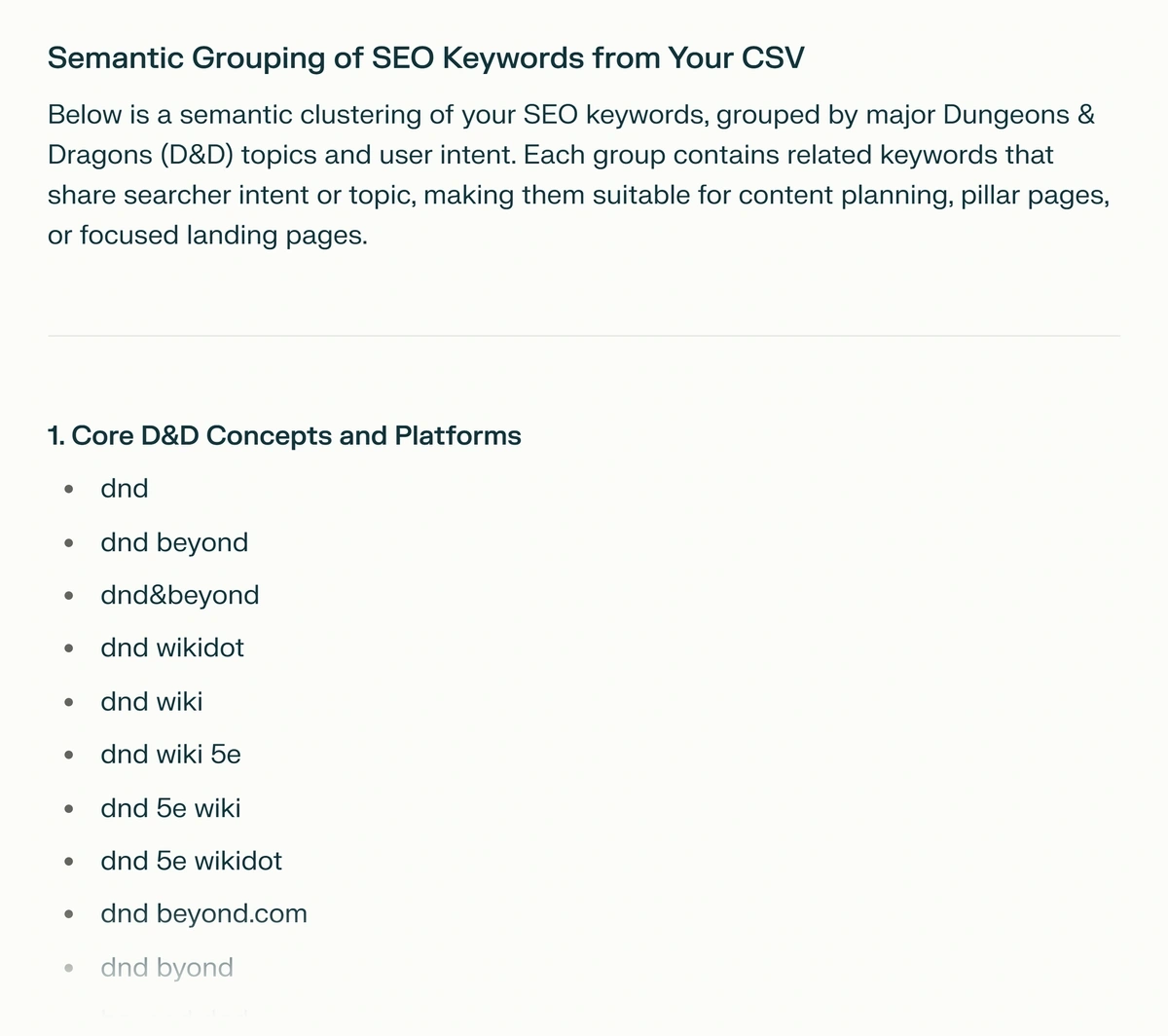
How to Build SEO Keyword Lists to Drive Results
Making an SEO keyword list is all about knowing the kind of content you want to create and then using tools to research content your readers are searching for.
Finding new keyword lists only takes a few steps, especially if you already have the topic for your site chosen or established. Even if you don't, that's okay. I'm here to walk you through the process.
Get More Search Traffic
Use trending keywords to create content your audience craves.
1. Define Your Audience Personas
Before making a list of keywords, think about your target audience. These people are your personas.
The more specific you can be when creating personas, the more high-quality keywords you will be able to generate.
For example, let's say you want to start a site about running shoes. A keyword like "running shoes for wide feet" indicates that someone is searching for a solution to a problem that you can solve. These keywords should have lower difficulty scores, too, which is an added bonus.
You can find keyword difficulty by using the Keyword Magic Tool.
Once you're clear about who you're targeting, you can create incredibly specialized content. The SEO keyword lists you make will target the people most likely to be interested in your site.
2. Brainstorm Seed Keywords
Once you have created your ideal customer persona, it's time to put yourself in their position and come up with the initial keywords you think they'll be searching for.
Start with your topic, your domain name, and site title (if you have those last two already). Most of the time, these will include the root keywords that will build the foundation of your site's content.
AI tools like ChatGPT and Google Gemini can be a lot of help in coming up with the first list of keywords. Using Gemini, I used this very basic prompt to get a list of seed keywords to begin research.
"I am doing keyword research for my running site. It will focus on runners with wide feet. Give me a list of seed keywords for SEO."
It returned the following seeds, as well as a few paragraphs of advice on how to expand the list for different search intents and long-tail keywords.
- Wide running shoes
- Running shoes for wide feet
- Running shoe width
- Running with wide feet
- Wide feet running
- Can I run with wide feet?
- Are my feet too wide to run?
Using the same prompt with ChatGPT, it generated a much larger list, broken apart into different categories. These were
- Core Keywords
- Informational/ Content Driven
- Brand/ Competitor-Based
- Commercial Intent/ Affiliate Potential
This is helpful because you can now use each of these sections to make an SEO keyword list for each one.
3. Focus on Real ProblemsYour Audience is Searching For
Looking at your list, figure out what keywords your target audience is actually searching for so that you can meet them where they are.
I suggest the Exploding Topics Free Keyword Research Tool or the Google Keyword Planner within the Google Ads platform.
Alongside Semrush, they're my two most-used resources for this task.
For this example, I'll use Semrush's Keyword Overview tool.
Paste the SEO keyword list you brainstormed above into the tool. Semrush will provide the Bulk Keyword Analysis, which includes search volume, keyword difficulty, search intent, and more for each entry.
In the example above, it's important to note that not all of the keywords listed get significant amounts of traffic.
The bottom three entries get no traffic. The two above those get negligible amounts.
Semrush includes these terms because they have received some search traffic in the past. However, they are currently not significant sources of search queries.
What this means for you is that people don't actually use those to search, so you can probably take them off your keyword list.
You can click the “For Metrics, Refresh” link on the right side if you want to ensure these have not begun trending since the last time Semrush updated.
Below, you can see this is not the case for these, so they should be taken off the keyword list for the website.
Next, you will want to export these keywords into a CSV list. Click the “Export” button in the upper-right.
Now, you can choose the top keyword lists you want to focus on. I pick the top two or three ranking keywords and click the linked keyword term.
Find the section labeled “Keyword Ideas”. Click on “View all keywords”.
Export this too, then open it as a spreadsheet.
The export also includes information such as volume, intent, and the various features a term's results page might have—such as a Featured Snippet, a People Also Ask section, or sitelinks.
When you get to work at creating and optimizing your content from the list, you can use these SERP features to ensure the highest likelihood of ranking in multiple places.
4. Analyze Your Competitors
Once you have the queries your users are searching for, you need to find out which keywords are working for other sites in your niche.
You can do this competitor analysis in a few different ways.
You can go to the websites you know of and manually check what kind of content they're publishing. This can give you a decent understanding of your competitors’ priorities.
However, you still have to read their blog articles and then infer and determine what to add to your SEO keyword list from there.
Semrush Organic Research is my go-to tool to get a precise look into exactly who my sites' main competitors are.
You can explore the different sites listed by this tool in the same way as you did the keyword lists in the previous step.
Additionally, you can export the keywords into a spreadsheet or other tool to keep track of them.
Once you've chosen which competitor to investigate first, you can use the Keyword Gap tool to find out what content they have that you don't, and vice versa. All you have to do is enter the URL of up to 5 sites you want to compare.
Types of Keyword Gap Lists
When the report finishes, Semrush will provide you with multiple keyword lists.
- Shared
- Missing
- Weak
- Strong
- Untapped
- Unique
- All
The most commonly used for competitor research are Weak and Missing.
Use the Weak list to find keywords that don’t rank well compared to competitors.
To succeed here, find ways to optimize your own content.
Use the Missing keyword list to find keywords competing sites rank for, but you don’t.
For these keywords, you’ll want to create new articles from scratch to target the missing terms.
If you are analyzing multiple URLs against your own, then this list will display keywords every URL ranks for, just not your site.
Also, pay attention to the Untapped keywords. If you are comparing your site against a single competitor, then it will work the same as Missing. However, if you enter multiple URLs, the Untapped keyword list displays keywords that at least one, but maybe not all, of your competitors ranks for and your site does not.
After you've run all the reports and exported them, be sure to consolidate all of the keywords into one spreadsheet.
5. Analyze Keyword Relevance
An issue that comes up with any keyword research or list creation is irrelevancy.
A keyword might look like it fits in, when the site or topic might not even be tangentially related.
For example, I have a Dungeons & Dragons blog, and two keywords that keep popping up in lists are "dnd nail polish" and "dnd gel polish." These appear in every Semrush keyword report I run alongside entries such as "dnd dice" and "dnd books."
Unfortunately, these keywords do not indicate a cosmetics brand collaboration.
The SERPs for these keywords bring up a brand of cosmetics called DND, so the keywords have nothing to do with the game I write about.
Therefore, I have to cull "dnd nail polish" and other variants from every SEO keyword list I compile.
Performing an audit of the SEO keyword list is a manual task. Tools can’t filter irrelevant keywords because it's impossible for a tool to have a nuanced understanding of your site.
You might be tempted to use ChatGPT or another AI agent to help with this. Unfortunately, this is one of the times you won't get good information back.
LLMs don't understand keyword relevancy well enough. They can’t distinguish between quality keywords in your niche and entries that appear to be relevant, but aren't.
Reasons Why You May Not Rank For High-Volume Keywords
Even if a keyword has high traffic potential, you may not be able to compete with another site in your niche.
There are a lot of factors at play with high-volume keywords, but these are the two most likely as to why your site won't rank:
- Larger, more established sites are already ranking. They likely have higher domain authority and better EEAT.
- The keyword might not be a direct fit for your niche. Even if the high-volume keyword technically fits the topic of your site, you might not have the topical authority to rank.
The second point comes down to your existing content library and your authority around the topic you want to cover.
If you only have a single piece of content on "running for weight loss", and you have hundreds on "wide running shoes", the "running for weight loss" article would likely be difficult to rank.
Your site would be overtaken by sites and experts that specialize in creating fitness content around weight loss.
A long-term plan might be to increase your topical authority by continually publishing content on that subject. But the content will probably not rank for a while until Google and other search engines evaluate your content and determine you are, indeed, an authority in that niche.
6. Group Keywords By Intent and Semantic Similarity
Grouping similar keywords in your spreadsheet helps you to focus your content around topics rather than individual terms.
And you can use AI to do the semantic grouping.
Tell ChatGPT (or your preferred LLM) that you want this list of keywords to be sorted and grouped semantically and by search intent.
The prompt I use for this is very basic:
I am going to give you a CSV file of SEO keywords, then I need you to sort and group them semantically. Do you understand what that means?
Then I upload the file to the tool, and for the simple, broad keyword "dnd," I get back groupings like the following groups:
- Core D&D Concepts and Platforms
- Character Creation & Management
- Classes & Subclasses
- Races & Species
- Equipment & Items
- Spells, Abilities & Mechanics
- Monsters, Creatures & NPCs
- Rules, Mechanics & Game Systems
- Maps, Tools & Play Aids
- D&D Merchandise, Miniatures & Accessories
- D&D Media, Pop Culture & Miscellaneous
- D&D Rules Editions, Books & Publications
- D&D Slang, Meaning, and Non-Gaming Uses
To illustrate the weakness in this strategy, I should mention that Perplexity grouped the "D&D for Nails & Cosmetics (Brand Overlap)," not understanding there is no brand overlap there.
However, it did at least segment those keywords to make them easy to remove in one go.
The Semrush Keyword Strategy Builder works similarly.
It can help you discern differences in search intent so that you can get multiple articles to rank—or just one—for a topic.
The manual part comes in when you need to verify the newly grouped results are grouped correctly. You can begin by checking the SERPs for overlap between search intents.
Use the Semrush Keyword Overview tool for this.
If you find that a set of similar keywords does not fulfill the same search intent, you can write articles targeting one group or another. You will have a chance to rank for both of the intents, in that case.
7. Evaluate Monthly Search Volume
When you run a keyword overview report in Semrush, you will see the term “volume” in various places.
In Semrush, “volume” is a rough indication of the number of monthly searches users perform for that query.
You can run reports for volume by country, global, or even narrow it down to regions and cities.
For example, you can find how many searches a particular keyword from your list has per month from users in Toronto, Ontario, Canada. Or from the entire state of Florida.
The monthly search volume is an indicator of what keywords you should focus on. But take it as an approximation.
If you find a phrase on the SEO keyword list you've compiled that has hundreds of thousands of searches per month, that sounds wonderful at first glance.
But there are a lot of other sites competing for the top spots.
That means higher competition, less chance you’ll rank, and lower conversions for you.
If you're a smaller site, or just getting started, these high-volume keywords probably aren't worth your time trying to rank for.
As I mentioned above, your topical authority, domain authority, and breadth of content published just can't compete with the major industry sites.
Want to Spy on Your Competition?
Explore competitors’ website traffic stats, discover growth points, and expand your market share.
However, if you check your list for long-tail keywords, many of these will have enough volume to get users to your site without the major sites in your industry targeting them aggressively.
Going back to the running shoes example, you can use brand names to find keywords that you have a chance to rank for.
In the screenshot below, "altra running shoes" is a long-tail keyword of the high-volume keyword "running shoes." While the volume is much lower, the transactional intent is much higher.
This is why you need to define your niche first. When you're working through the keyword lists, you don't want to spend time and effort on keywords you can't rank for.
That's not to say that high-volume keywords are unreachable. In your research, you will find plenty of search terms that lots of people search for, yet few sites create content for.
You can take advantage of that, create the content, and top the SERPs.
8. Check Keyword Difficulty
Monthly search volume is not the only deciding factor when choosing which keywords on your list are worth focusing on. Another major consideration should be keyword difficulty.
Keyword difficulty is a percentage score that shows the likelihood you'll rank for a given keyword.
If you have two keywords with roughly similar monthly volume, but one has a much lower keyword difficulty, choose that one to prioritize.
Think of these as low-competition keywords.
Some queries on your SEO keyword list might have relatively high monthly volumes, but low difficulty.
That means that a lot of people want that information, but very few sites are providing it.
When reviewing keyword difficulty metrics, prioritize keywords on your list that are under 50%.
You will certainly target keywords with higher percentages than that, but they shouldn't be the first ones that you work with on a new list of SEO keywords.
Bonus Tip: Get a List of Keywords You're Already Ranking For
Find keywords you already rank for with our free Google Rank Checker tool, which tracks your positions across over a billion keywords.
Make a list of keywords that are not ranking on page 1 (that means they’re not in positions 1-10). If keywords are just outside the top 10 positions, improving the content is often enough to move them onto the first page.
Lower-ranked keywords on the second and third pages may require a deeper edit to increase performance.
If content on your site ranks below the 20th position, there's a significant issue preventing them from ranking.
- Perhaps you have low authority for that particular topic
- The content itself may have poor relevance to the search intent
- It could have decent relevance, but the content itself isn't as high-quality as the pages ranking in the SERPs
There are a few things you can do in this situation.
If the issue is poor relevance to search intent, use the Semrush Keyword Overview tool. Find the “Intent” box.
In Semrush, search intent is broken down into four different categories.
- Informational is when the user wants to find specific information or answer a particular question
- Navigational is when the person wants to arrive at a specific site
- Commercial intent is when a potential customer is investigating brands, services, or products
- Transactional is when the user is ready to take action, like making a purchase
If the tool says the intent is Transactional, but your page is purely Informational, you likely will not rank. Revise your post or page to meet the new search intent, and almost certainly see your rankings improve.
What's Next After Creating Your SEO Keyword List?
Now you know how to make the SEO keyword lists that should start your site's climb to the top of the SERPs in no time.
With your insight into how to make SEO keyword lists and knowledge of the numerous tools available, you're ready to hone your keyword optimization strategies.
Sign up for Semrush today so that you can use the tools like Keyword Magic and Gap Analysis, get traffic analysis and domain overviews, and find out what keywords your site needs.
You'll have everything you need to win new featured snippets, boost the rankings of content that has fallen behind, and even diversify the range of content your site provides to users.
Stop Guessing, Start Growing 🚀
Use real-time topic data to create content that resonates and brings results.
Exploding Topics is owned by Semrush. Our mission is to provide accurate data and expert insights on emerging trends. Unless otherwise noted, this page’s content was written by either an employee or a paid contractor of Semrush Inc.
Share
Newsletter Signup
By clicking “Subscribe” you agree to Semrush Privacy Policy and consent to Semrush using your contact data for newsletter purposes
Written By


BJ has over fifteen years of experience in content management and SEO. He has worked as a content team lead and editor at major Sa... Read more

